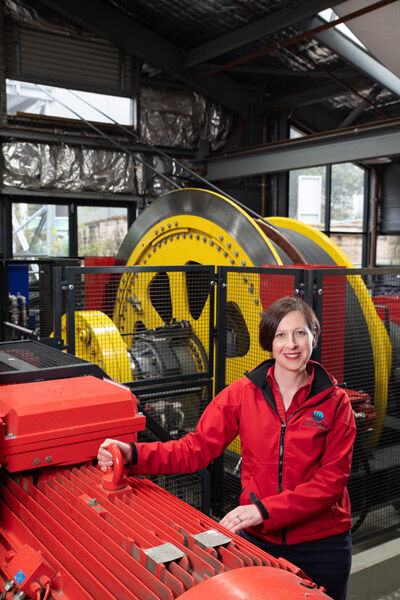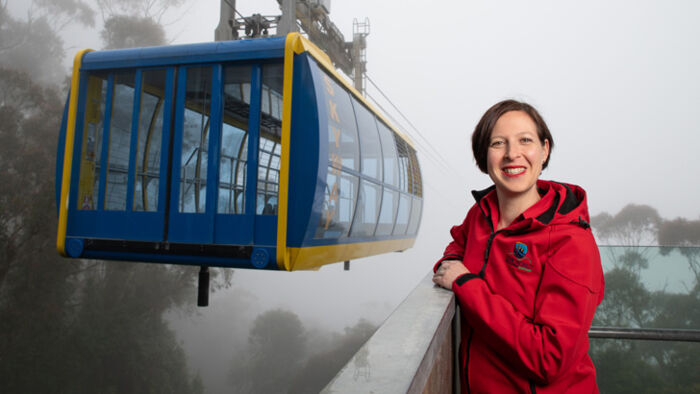Scenic World's Anthea Hammon on life in the family business
By Kanika Sood
For many Sydneysiders, the Blue Mountains is a go-to getaway and the best seat in the house from which to experience the region's spectacular beauty is Scenic World. Its steep railway (steepest in the world, according to its website), Scenic Skyway, and Scenic Cableway provide magnificent views of World Heritage sites and access to walkways through dense foliage. This is where Anthea Hammon works.
For all its beauty, the Scenic World site was originally used in the late 19th century to haul coal and shale mined in the Jamison Valley below. It was owned by John Britty North, who established Katoomba Coal Mine. He sold the lease of the colliery in 1945 to Harry Hammon, who with his wife Mary had two children named Philip and Julie.
Philip took over from his father in 1994 and ran the business for nearly 17 years before passing the baton to two of his five children, Anthea and David.
For Anthea Hammon, the love for the family's asset and the engineering that is its backbone took root early. "I used to follow my dad [Philip] around because he always worked Sundays," she says.
"I loved watching it all and thought, 'Wow, it must be cool to build those.'
"The steepest train in the world is a pretty amazing piece of machinery and it's way bigger than you, and pretty cool to be looking at."
As she got older, Hammon worked in front-of-house areas such as ticketing and retail. In 1993, as she was starting high school, Scenic World undertook a major overhaul of the Scenic Railway.
"I remember I got the day off to come and watch them craning the big winch into the winch room. They had to take the roof off. And getting to watch those really big engineering feats was just fascinating," she says.
Her love for engineering held and when it was time to pick a university course, Hammon chose mechanical engineering at UNSW. She finished with first-class honours, a co-op scholarship and about 18-months' work experience across four other businesses.
At that time, her father needed help in the business with maintenance so she returned in 2003 and stayed.
"At the end of that [university] I said, 'Well, I don't really want to go work in a car manufacturing plant or with fast-moving consumer goods.' I was happy to come back to the family business and help Dad work out some of the engineering and maintenance challenges he was having," she says.
The decision was a return to familiar territory. As a child, she spent a lot of time in the bush behind the family home, with her three sisters, Arabella, Emily and Lydia, and her brother David, who also returned to the family business after studying economics and commerce at the Australian National University.
In the years since, Hammons Holdings, the operating company, has expanded beyond Scenic World. In 2018, it acquired the rights to operate BridgeClimb, which lets tourists scale the Sydney Harbour Bridge, and it also has stakes in Sydney Zoo in the western suburbs and a Melbourne surf park.
Amusement parks, the general category in which the family's holdings sit, have been hit hard by COVID-19, the ban on foreign travel and the general increase in unemployment. However, IBISWorld estimates the $1.5 billion industry (in revenue terms) is growing at 2.3% a year and running a profit margin of 12.7%.
In a normal year, Scenic World would welcome an average of 1 million visitors, making it the largest privately-owned attraction in Australia. How long it takes for the industry to return to these long-term levels is a billion-dollar question.
And one that is impossible to answer without a crystal ball, says Hammon.
Meanwhile, the family has looked to diversify outside its recreational assets in recent years, including buying some properties near Scenic World, which Hammon hopes will be of strategic value to the park in the future. It is one of the fruits of a stronger governance structure that the operating company's board has tilted towards in recent years.
Around 2006, they added a family council that looks after the human elements of the family business and is separate from the board of Hammons Holdings. The family council has seven members: Philip Hammon, and his wife and five children.
"The family council meets every six months. Its role is to oversee the family side of the business. It gets a business update [and] we might talk about succession planning, next generation, philanthropy - stuff that is not business strategy, because obviously that is the board's role - but our family-related business," she says.
"We got to a point where we had a couple of family members sitting on the board. And we decided that [it was] the best thing to do and our accountant [Grant Thornton] has been an excellent adviser through that process and also at about that time we connected with Family Business Australia."
The family also invites a consultant to act as an emotional facilitator to its biannual meetings.
"At a family level, those things [philanthropy and succession planning] can be more heated. So we have someone that just keeps tabs on us all and if there's an emotional issue that comes up, then will brief us before or debrief with us afterwards and can sort of call time-out at the meeting to just help us," explains Hammon.
"We're getting better at doing it ourselves. But it's a journey, especially because there's so many, with seven people on the family council."
The council idea was born at the time of the handover from Harry Hammon to Anthea's father, Philip.
"My grandfather was a typical first-generation dictator," she says. "He thought he was never going to die, never wanted to hand it over, never gave my father any opportunity to grow the business. He ended up getting dementia and we had to get a carer for him because he was still trying to come to work every day - he refused to retire."

Eventually, Harry Hammon did pass away and left a fuzzy will; his children had to decide among themselves on the ownership of the assets. It was also a lesson for his son Philip, who wanted the next intergenerational transfer to be more orderly.
"Dad very much said, 'Okay, right, that's not going to happen to this next generation. There's five of you, it could turn into a very big mess. We're going to make sure that we're managing this properly,'" says Hammon.
When it came time for Philip to retire, Anthea and David were already working in the business with strikingly complementary skill sets.
"Interestingly, Dad sort of said, 'Oh, I'm gonna write a book about the history of the site with another guy. You guys look after the place. If any questions, I am here, come see me,'" she says.
They went from being employees to running the business, with weekly catch-ups with the patriarch. The result was a smoother transition to the next leadership, and in 2011 the duo took over as joint managing directors as their father retired.
"We had a couple of facilitated conversations with Dad to make sure that his exit out of the business was done in a really respectful and great way," says Hammon. "He was a little bit hesitant to go. But I think one of the things that we talked about as a sibling group was what is he going to do next because we're all very much of the philosophy in our family that you need something to retire to, not to retire for.
"He always loved dancing but that wasn't going to be enough. So we bought him a drum kit and a train set and built up what he was really going to do when he retired. By the time he retired ... he actually was so busy outside of work, he really didn't want to be at work anymore."
In another governance change, the family invited outsiders to sit on the Hammons Holdings board as independent, non-executive directors. The board now has five members: Philip, Anthea, David and two non-executive directors who were added in 2016.
The family decided it wanted directors with experience in family businesses, some tourism services experience and a strong financial background. Two people were found who fit the bill - former Electrolux executive Owen Morgan and former Qantas and Avis executive Gordon Howard.
"I think one of the challenges in a family business is that you can get non-executive directors onto the board, and then the family members just overrule them ... But we wanted someone with the strength of character to be able to push back and challenge us because the business is only going to get better through that diversity of thought. David and I appreciated having that questioning voice and that challenging voice coming from the directors."
The Hammon family council is on an educational journey with the fourth generation.
"We are working on that next-generation plan of how to keep them engaged in the business, how to get them interested and then how to build their experience ... because no matter what, they will end up being owners of the business," she says. "So they will need to know something about it and will need to know enough to be able to make appropriate decisions for it at an ownership level, [if] not necessarily at a board level."
On the way, Hammon started a family of her own. She met her now-husband, Ian Jay, in high school and reconnected with him later. They have two children, five-year-old Hazel and one-year-old Hamilton.
With her first child, she says, her brother thought she would be out of the business for six months but she came back in six weeks. With her second child, she was back less than a week later.
"I guess the real privilege of being in the family business and being the leader ... is you can make up [your] own rules a little. So the baby just came to work with me. The first three months with my daughter and five months with my son, they just traipsed around with me."
She eventually got a nanny, but Hamilton went to dinners with the tourism minister and meetings of the Western Sydney Airport board, on which his mother sits - all before his first birthday.
With her own distributions from the family business, Hammon says with a laugh that she invests in her mortgage. Switzerland, with its similar cable cars and ski slopes, is a favourite holiday spot, while Disneyland with its large revenues and amazing customer service is a favourite amusement park.
For all its work on governance, the family business's goal is to generate long-term wealth - for 100 years or more. Hammon says the family is regularly approached by potential suitors for its assets. But it has no plans to change ownership. So succession is something they will have to revisit in a few decades.
While Hammon's generation only had five heirs, those five now have 13 children. The youngest is her son at a year old and the eldest is a 13-year-old.
Get stories like this in our newsletters.



